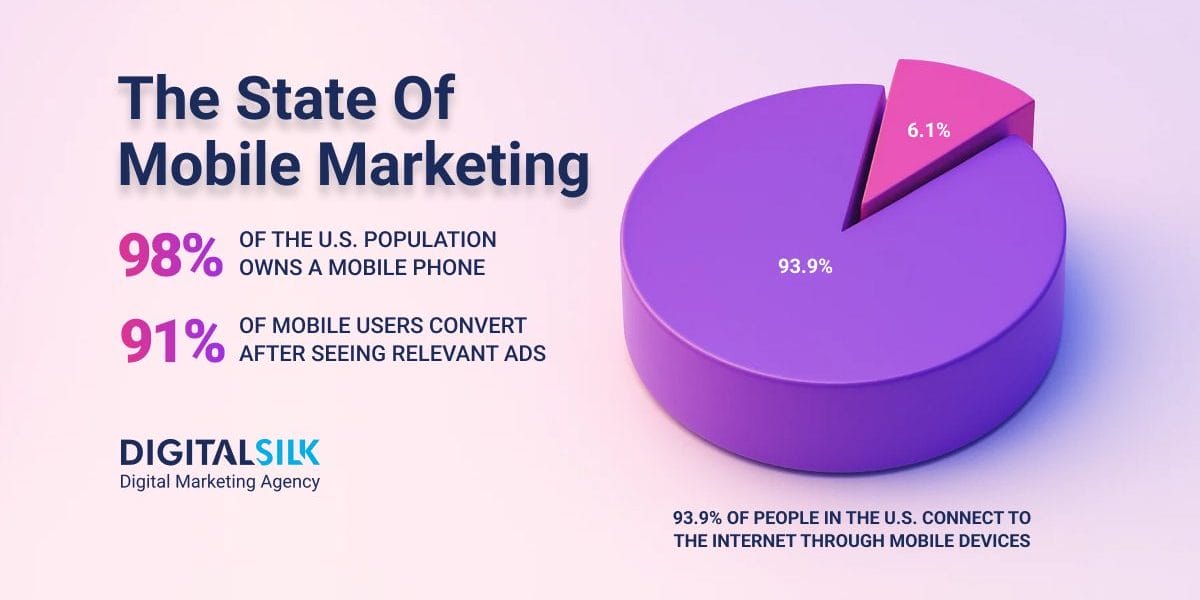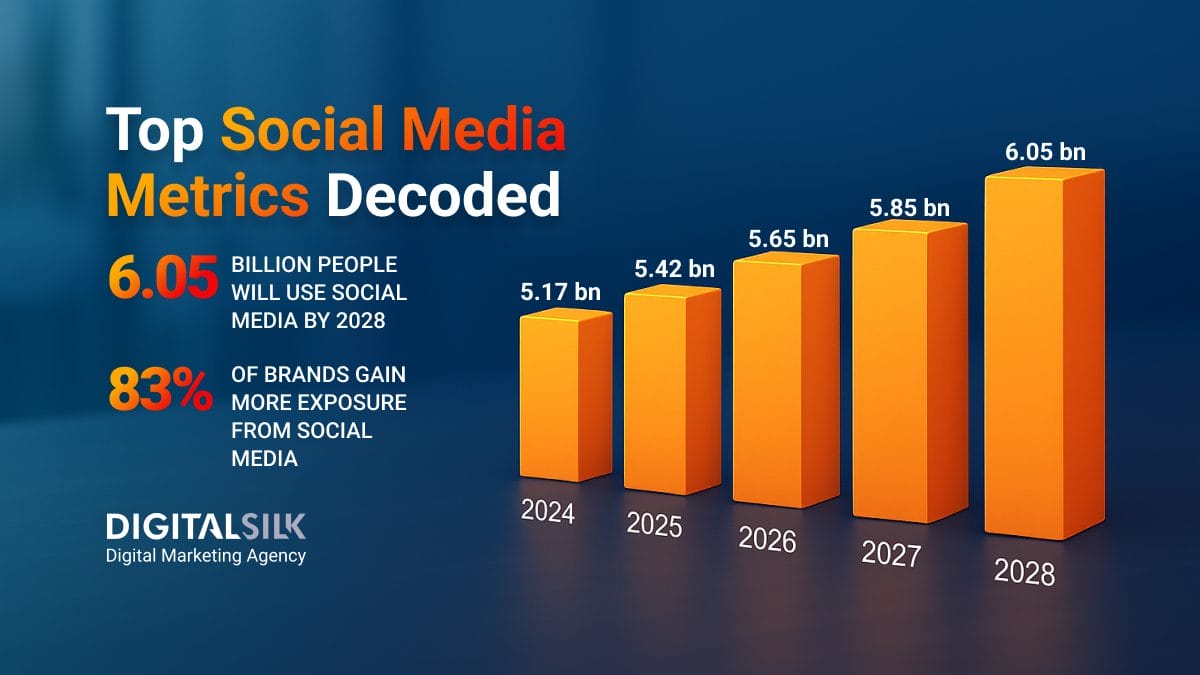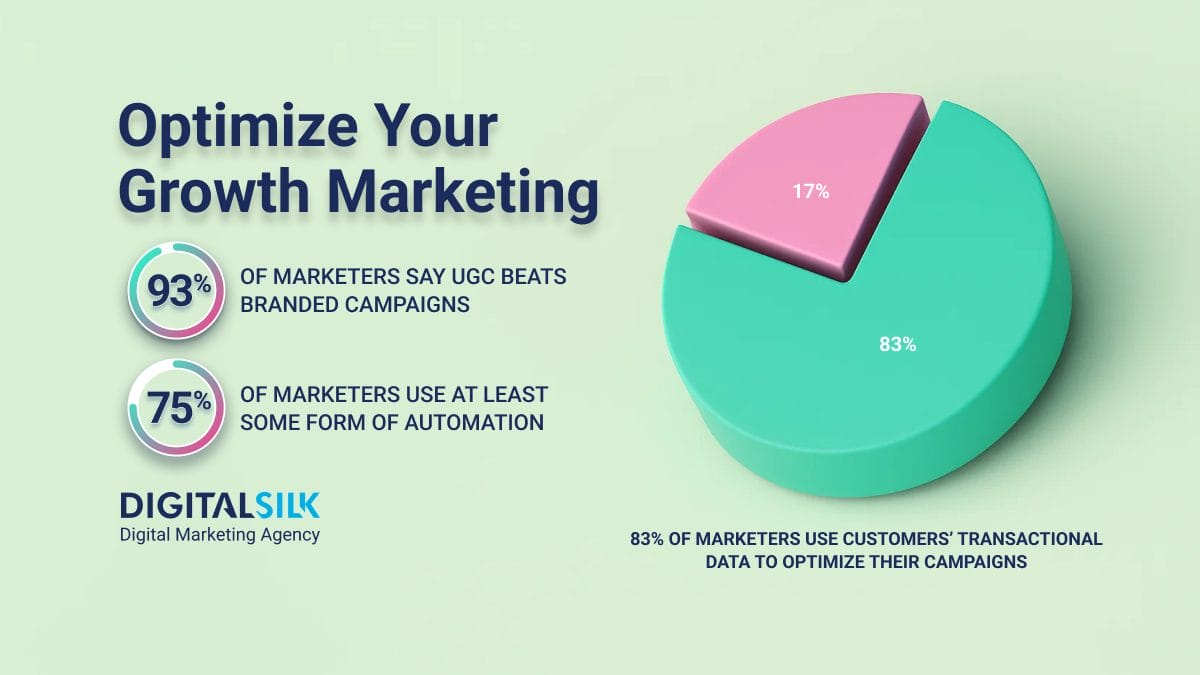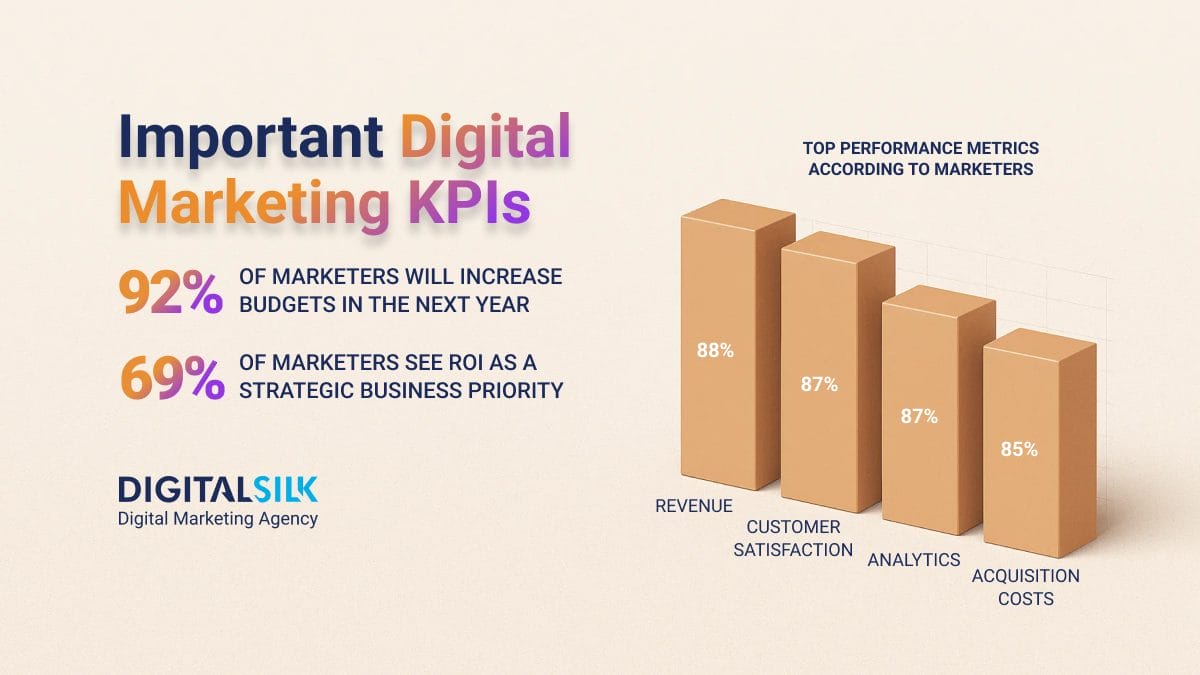Mobile Marketing Statistics: Key Highlights
-
91% of smartphone users say they have made or planned a purchase after seeing a mobile ad that felt relevant and timely.
-
Mobile dominates digital advertising, projected to account for 69.61% of total global ad revenue by 2028.
-
50% of consumers prefer browsing a company’s mobile site instead of installing an app.
The first thing most people reach for each morning isn’t coffee. It’s their phone.
That moment defines today’s marketing reality: mobile is where attention lives.
Every tap generates data that helps brands understand what audiences want, when they want it and how they act.
With the global mobile marketing market valued at $18.90 billion in 2024 and projected to reach $81.74 billion by 2030 at a CAGR of 23.9%, it’s clear that mobile is driving a new standard for precision and performance.
The following 30 mobile marketing statistics highlight how audiences engage, how mobile ads drive Return on Investment (ROI) and how brands are reshaping digital strategies for 2026.
General Mobile Marketing Stats
Mobile connects brands and consumers in ways that feel immediate, personal and constant.
It’s where curiosity turns into action and where attention is measured in seconds but can lead to lasting impact.
The mobile marketing facts below capture how this dynamic space continues to grow, shaping both strategy and consumer behavior across every touchpoint.
- The global mobile marketing market is projected to reach $99.18 billion by 2033, growing at a CAGR of 18.1% between 2025 and 2033.
- CMOs in the United States devote 23.3% of their total marketing budget to mobile.
- Mobile penetration in the U.S. stands at 98%, with smartphones accounting for 91% of ownership, marking one of the highest adoption rates globally.
- In 2024, the yearly in-app purchase (IAP) revenue reached $69.2 billion worldwide.
- The average user spends 3.5 hours per day across Android and iOS devices.
What These Numbers Mean For You
- Reassess mobile budget priorities. Ensure mobile investments align with where audiences spend the most time and attention to maximize reach.
- Refine in-app monetization strategies. Focus on creating value-driven in-app experiences that balance user engagement with sustainable revenue growth.
- Optimize for micro-moment engagement. Design marketing touchpoints around brief, high-intent interactions that influence decisions throughout the day.
How Effective Is Mobile Advertising?
Advertising represents the most deliberate expression of marketing, where strategy translates into strategic communication that influences behavior and drives demand.
On mobile, it operates in a uniquely immediate environment where context, timing and personalization determine impact.
The mobile advertising statistics below examine how investment, audience intent and platform performance determine brand visibility.
- 91% of smartphone users report making or planning a purchase after encountering an ad they deemed relevant.
- By 2028, mobile is projected to account for 69.61% of global digital advertising revenue.
- The U.S. is the largest mobile advertising market in the world, with spending totaling $233.35 billion in 2025.
- In 2025, mobile advertising spending in the United States is projected to reach $228.12 billion, with $187.78 billion coming from in-app ads and $40.34 billion from web-based ads.
- Search advertising tops the list of mobile ad formats in 2025, with U.S. spending reaching $97.7 billion.
- By 2029, mobile search advertising will dominate the U.S. market with $147.63 billion in ad spending.
- Social media leads U.S. digital advertising touchpoints in 2025, engaging 50% of audiences.
- In the U.S., 59% of digital media professionals consider social media the most vulnerable channel to ad fraud.
- 25% of mobile users in the United States say ads in mobile gaming apps are the most frustrating type.
- 8% of adult mobile users in the United States use ad blockers and anti-tracking services.
What These Numbers Mean For You
- Prioritize mobile-first ad strategy. Direct spend toward mobile channels that deliver immediate reach and influence as user attention continues to shift from desktop.
- Capitalize on mobile search trends. Strengthen search visibility with campaigns built for intent-driven behavior, where timing and relevance directly shape outcomes.
- Prepare for intensified competition. Rising ad spend signals a more crowded mobile marketplace, demanding smarter targeting, real-time optimization and continuous testing.
How Many Users Access Websites With Mobile?
What percent of web traffic is from mobile?
The answer reflects how deeply mobile use is embedded in daily digital behavior, with most users now turning to their phones as their primary way to browse and search online.
According to recent mobile search statistics, this shift has made mobile performance and accessibility central to how brands capture attention and sustain engagement.
- As of September 2025, total mobile web traffic reached 56.74% globally and 44.29% in the United States.
- In the first quarter of 2025, global mobile website traffic reached 62.73%.
- 96.3% of people worldwide use mobile devices to access the internet, placing mobile at the top of global connectivity.
- In the U.S., 93.9% of the population connects to the internet through mobile devices.
- 94.4% of global consumers use mobile phones to browse social networks, while 82.3% of them use these devices to access search engines or web portals.
- Google accounts for 89.73% of global mobile search traffic, with Bing trailing behind at 3.98%.
- 68.34% of mobile website traffic comes from Chrome, followed by Safari at 17.12%.
- Mobile devices drove 77% of retail web visits and 69% of total eCommerce orders in the second quarter of 2025.
What These Numbers Mean For You
- Strengthen cross-channel consistency. Ensure mobile campaigns align with social, search and retail touchpoints to maintain message coherence across user journeys.
- Invest in social-mobile synergy. With most users accessing social platforms on mobile, design campaigns that integrate paid social and organic engagement seamlessly.
- Refine browser-specific optimization. Focus on Chrome and Safari performance, where the majority of mobile website traffic occurs.
Mobile-Friendly Website Statistics
In mobile phone marketing, visibility begins with discovery but securing long-term loyalty and preference depends on how well a website performs once visitors arrive.
A mobile site that loads quickly, feels intuitive and keeps attention can turn casual browsing into meaningful engagement.
The statistics below highlight how usability, speed and overall experience determine whether mobile visibility leads to real results.
- 50% of smartphone users choose to browse or shop via a company’s mobile site instead of installing an app.
- The average website visit duration on mobile was 2.2 minutes in 2024, compared to desktops 5.1-minute-long sessions.
- Mobile’s average number of page views per session was 4.2 in 2024, as opposed to desktop’s 4.9.
- Mobile devices convert at a rate of 2.03%, less than half the desktop conversion rate.
- In 2024, 40.1% of user sessions showed signs of frustration, most commonly caused by slow page loads and JavaScript errors.
- Mobile users exhibit the highest bounce rate across industries, measured at 50.3%.
What These Numbers Mean For You
- Audit mobile site performance. Ensure that site speed, navigation and design support the growing share of users accessing websites via mobile devices.
- Optimize for search visibility. Align content and technical SEO with mobile search behavior to improve discoverability and engagement across devices.
- Improve engagement depth. Encourage longer visits and more page views per session through relevant content and seamless browsing flows.
Leading Mobile Marketing Strategies You Should Try
Recent mobile marketing statistics highlight how people discover brands, interact with content and make purchase decisions on their phones.
But the following strategies can help you turn those insights into long-term strategies that grow visibility and build meaningful engagement:
- Optimize for smaller screens: Ensure your content, ads, and website layouts load quickly, display clearly and adapt seamlessly to different devices.
- Use personalization to strengthen connections. Tailor offers, messaging, and timing based on user behavior, location and browsing history to make each interaction more relevant.
- Strengthen local targeting: Use location-based data to reach users with relevant offers or messages at the right moment.
- Invest in in-app engagement: Build deeper relationships with mobile users through personalized push notifications, loyalty features or exclusive content.
- Prioritize mobile-friendly content. Create short, clear copy and visuals that are easy to scan, with headlines and calls-to-action (CTAs) that stand out immediately.
- Test across browsers and platforms: Regularly check how your campaigns perform on Chrome, Safari, and other major mobile environments to ensure consistency.
- Use analytics to refine campaigns: Track performance metrics drawn from mobile marketing statistics to identify what resonates, where users drop off and how to improve.
Optimize Your Mobile Marketing Strategy With Digital Silk
In a world where attention shifts in seconds and decisions happen on the go, mobile now defines how people discover, evaluate and engage with brands.
Companies that align their marketing strategies with real user behavior build stronger connections and sustained growth.
Digital Silk optimizes digital marketing for mobile devices through strategy, design and performance solutions that help brands reach audiences seamlessly across every touchpoint.
As a full-service digital marketing agency, we offer:
- Premium digital marketing solutions
- SEO services
- PPC management
- Social media marketing
- Branding services
- Custom web design
Our experts manage the full scope of work, combining performance-driven oversight with transparent communication.
Contact our team, call us at (800) 206-9413 or fill in the Request a Quote form below to schedule a consultation.
"*" indicates required fields









